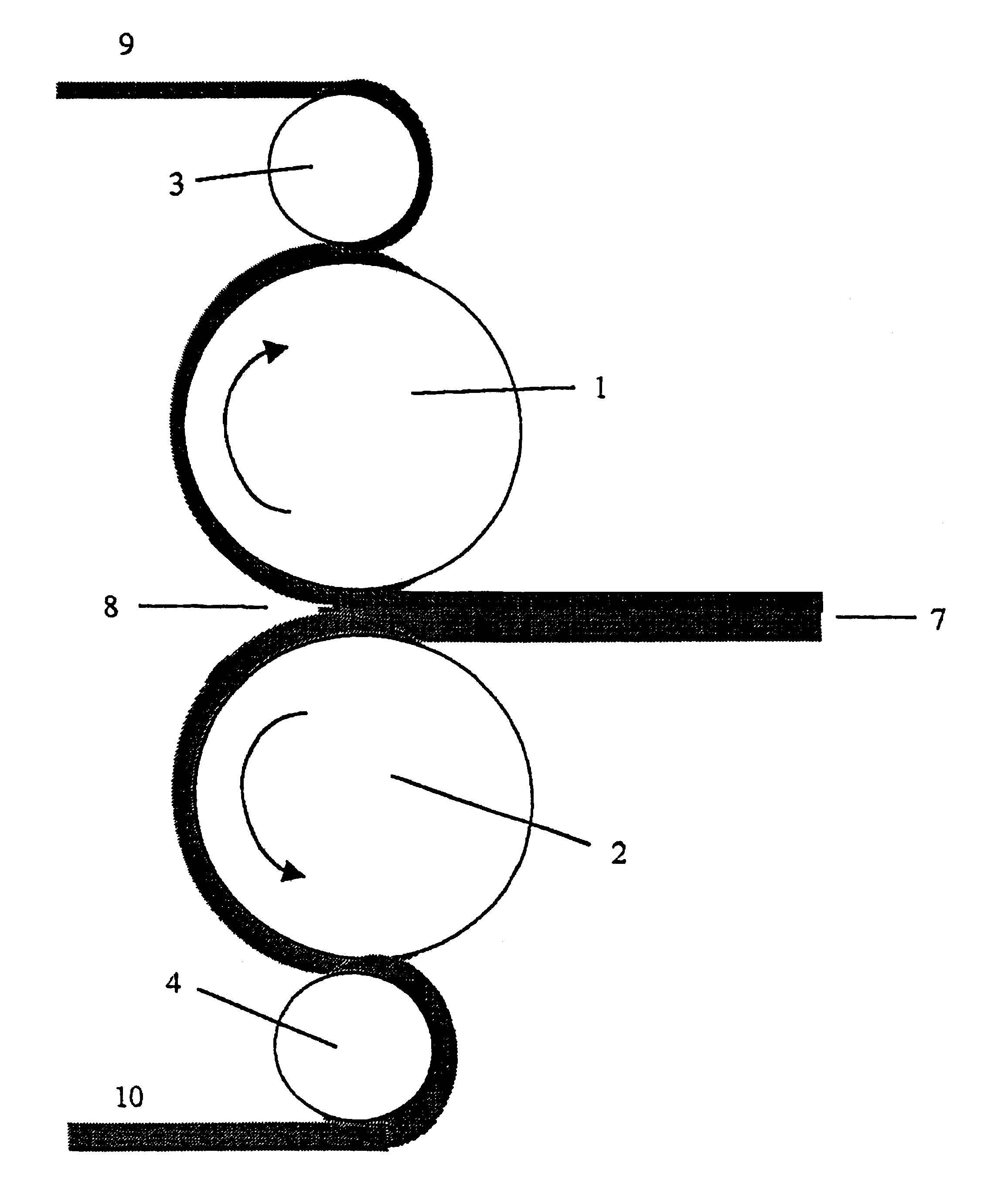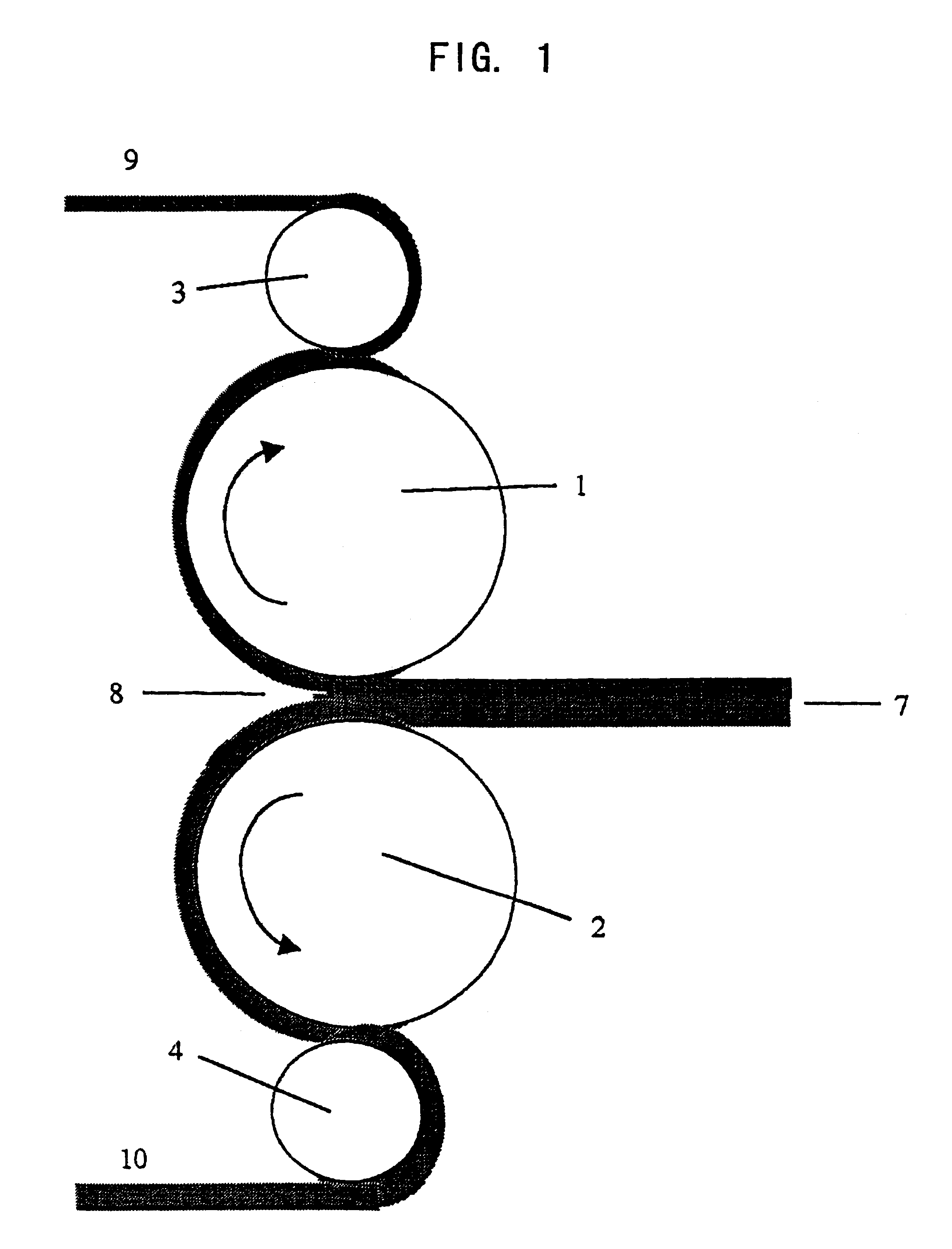Multi-layer paper peelable into at least two thin sheets
a multi-layer paper and peeling technology, applied in the field of multi-layer paper, can solve the problems of high production cost, difficult to prepare tissue paper having a small basis weight, and limit the thickness of producible tissue paper, and achieve the effect of low density and low basis weigh
- Summary
- Abstract
- Description
- Claims
- Application Information
AI Technical Summary
Benefits of technology
Problems solved by technology
Method used
Image
Examples
example 2
[0191]60 Mass % of non-stretched polyester fibers (TEPYRUS TKO8PN manufactured by Teijin Ltd.) having a fineness of 0.2 dtex and a length of 3 mm were mixed with 40 mass % of polyester binder fibers (sheath component: low melting point PET, fusing temperature: 110° C.; core component: PET; SOFIT N720 manufactured by Kuraray Co., Ltd.) having a fineness of 1.7 dtex and a length of 5 mm, to which an acrylamide-type dispersing agent (ACRYPERSE P-NS manufactured by Diafoc Co., Ltd.) was added in an amount of 0.3 mass % (based on total fibers) to obtain a stock for a first layer. The first layer of polyester fibers was formed on a wire of a TAPPI standard sheet machine in an amount corresponding to a basis weight of 5 g / m2. A Manila hemp pulp was beaten to Canadian Standard freeness (CSF) 550 to obtain a stock for a second layer. The second layer of the Manila hemp fibers was formed on a wire of a TAPPI standard sheet machine in an amount corresponding to a basis weight of 8 g / m2. Next, ...
example 3
[0195]Example 2 was repeated in the same manner as described except that the basis weight of the polyester fiber layers was reduced to 1 g / m2 to obtain a unified 3-layer paper. A biaxially oriented polyester film having a thickness of 2.0 μm was bonded with an adhesive to each of the opposing surfaces of the 3-layer paper to obtain a laminate sheet (reinforced multi-layer paper material). The laminate sheet was found to be delaminatable at the interface between the first and second layers. The physical properties of the three-layer paper were as shown in Table 1.
Preparation of Heat-Sensitive Stencil Printing Master:
[0196]A 10 mass % ethyl acetate solution of a damp-setting type polyurethane resin (TAKENATE manufactured by Takeda Chemical Industries Ltd.) was applied in an amount of 0.4 g / m2 (on dry basis) on one surface of a biaxially oriented polyester film having a thickness of 2.0 μm and dried with a dryer. This was then superimposed on the 3-layer paper obtained above such that ...
example 4
[0197]Example 2 was repeated in the same manner as described except that each of the polyester fiber layers was composed of 80 mass % of non-stretched polyester fibers (TKO8PN manufactured by Teijin Ltd.) having a fineness of 0.2 dtex and a length of 3 mm and 20 mass % of polyester binder fibers (sheath component: low melting point PET, fusing temperature: 110° C.; core component: PET; SOFIT N720 manufactured by Kuraray Co., Ltd.) having a fineness of 1.7 dtex and a length of 5 mm to obtain a 3-layer paper. The peel strength of the 3-layer paper was found to be 1.76 N / m between the first polyester fiber layer and the Manila hemp layer and 1.79 N / m between the second polyester fiber layer and the Manila hemp layer. The 3-layer paper was able to be uniformly separated into three tissue sheets, namely two polyester fiber tissue sheets and one Manila hemp sheet. The physical properties of the 3-layer paper and the tissue sheets are shown in Table 1. Fuzz of the peeled surfaces and liber...
PUM
| Property | Measurement | Unit |
|---|---|---|
| Temperature | aaaaa | aaaaa |
| Percent by mass | aaaaa | aaaaa |
| Percent by mass | aaaaa | aaaaa |
Abstract
Description
Claims
Application Information
 Login to View More
Login to View More - R&D
- Intellectual Property
- Life Sciences
- Materials
- Tech Scout
- Unparalleled Data Quality
- Higher Quality Content
- 60% Fewer Hallucinations
Browse by: Latest US Patents, China's latest patents, Technical Efficacy Thesaurus, Application Domain, Technology Topic, Popular Technical Reports.
© 2025 PatSnap. All rights reserved.Legal|Privacy policy|Modern Slavery Act Transparency Statement|Sitemap|About US| Contact US: help@patsnap.com



